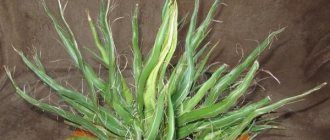Author's rating
Author of the article
Yakov Pavlovich
Professor, Head of the Department of Vegetable Growing
Articles written
153
Dwarf varieties of roses are successfully grown by gardeners in their gardens, houses and apartments. Miniature bushes are characterized by a long flowering period and varied bud colors.
With proper care and agricultural technology, the Cordana rose variety pleases with lush flowering from mid-spring to late autumn. But we’ll look into the details further on how to properly grow a flowering shrub.
Selection and description
The Cordana variety was obtained by selecting dwarf varieties of tea roses brought from China at the beginning of the 19th century.
The author of the new potted plant is the famous flower breeder Wilhelm Cordes, in whose honor the miniature rose got its name.
The compact rose flower bush is demanding in terms of growing conditions and care. Therefore, before growing Cordana roses, you must carefully read the detailed description of the plant.
- Mature bushes are small, reaching a maximum height of 25-30 centimeters.
- The plant is covered with dark green leaf blades, the shape and structure characteristic of this crop.
- The period of rapid flowering begins in mid-spring and continues until the end of autumn.
- The buds are of a standard shape and structure, the color is varied, depending on the variety and variety of the plant.
Reference! Miniature roses take root well at home and in the open ground of gardens and summer cottages. Used for planting flower beds, flower borders and creating landscape design in personal plots.
https://youtu.be/https://www.youtube.com/watch?v=hlndnNQFzKs
_
Botanical description of the plant
Cordana bush is small - 30 cm in height, average density. Thin, erect stems are covered with small dark green foliage. The buds that appear at the end of spring turn into classic goblet-shaped flowers in white, pink, and yellow. There is no aroma. Flowering continues until mid-autumn.
Varieties of varieties and color variations
Thanks to the fruitful work of breeders, many varietal varieties of miniature roses were obtained.
- The Mix variety is resistant to weather changes and easily takes root in open ground and at home. Multi-colored buds open in early May and bloom until the end of October.
- Cordana variety Mini Caliber blooms with small flowers in bright orange and red shades. Flowering is abundant and continues until the first frost.
- The Pasadena variety is resistant to diseases and harmful insects. During the flowering period, burgundy and dark red buds bloom on the plants.
- The lush flowers of the dwarf rose variety Ballet are shaped like a ballet tutu and painted in a bright coral color.
- Cordana variety Pearl blooms with multiple flowers in cream or white shades.
- The Kiss rose is characterized by excellent resistance to low temperatures and blooms with burgundy or red flowers.
Also resistant to weather changes is a rose with soft apricot flowers called Impala. And the Magnolia variety is characterized by cream flowers and bright green edging around the edges.
Expert opinion
Stanislav Pavlovich
Gardener with 17 years of experience and our expert
Ask a Question
Important! Each varietal variety of Cordana rose has its own requirements for growing conditions and care.
Autumn rose care
At this time, there is no longer any need to remove fading flowers, otherwise the rose bushes will begin to throw out new shoots, trying to fulfill their maternal duty: to give a flower, which should then turn into a fruit. If you refrain from pruning, the shoot will mature and gradually undergo the necessary chemical processes that will prepare the plant for low temperatures. Sugar will move from the leaves to the stems, reduce the formation of ice crystals in them, and protect the plant cells from rupture. This rose will be able to withstand lower temperatures.
In general, it is better to try to protect roses from the accumulation of water in late autumn. Especially if it is water that gets on the stems during autumn rains. To the point where you can cover the bushes with film.
In October, you can gradually begin to clean the bushes . Especially carefully you need to collect and remove leaves with the slightest signs of disease if the roses contracted some kind of illness in the summer. After all, if you do not remove the infected leaves, then under the shelter in winter a very favorable atmosphere will be created for the development of diseases and the proliferation of fungal spores. It is better to remove healthy leaves just before covering. If you do this too early, you can stimulate the rose to form new leaves; the buds will wake up, and the frost will be destructive for them.
In my opinion, it is better not to prune roses in the fall. Even immature shoots should not be removed - pruning can cause the growth of young shoots that do not have time to ripen and die in the winter. I only remove what can become a source for the development of infection during wintering.
In the fall, we gradually remove leaves from the bush, especially diseased ones.
Very late, almost before sheltering, I remove the tips of immature shoots, flowers, and parts of the plant that are clearly affected by disease (with spots of mold, rust).
Features of roses and advantages of growing
The main feature of the Cordana rose is its complete lack of aroma. For many, this property of the plant is a disadvantage. But for people prone to allergic reactions, growing such a flower will bring a lot of joy and pleasure.
See also: Care and cultivation of climbing roses in open ground
Before growing a miniature rose, you need to find out all the pros and cons of the plant.
Advantages:
- long flowering period;
- if comfortable conditions are created, flowering of bushes is possible in winter;
- lack of aroma, which allows you to grow roses if you are prone to allergies;
- large selection of color shades;
- the possibility of growing rose bushes in open ground and at home.
The main disadvantage of the culture is that plants are demanding in terms of growing conditions and care.
Flower pests
Pests can attack any plant, but the capricious Rose Cordana is especially susceptible to them. It is considered especially fragile during the period of shoot development, since insects especially love buds and emerging flowers.
In the garden, plants can be attacked by both ordinary caterpillars and larvae of pests that slow down the growth of the plant. Their presence can be determined by the holes appearing on the leaves of the Rose.
Pests hunt for cell sap, which destroys the development process of the entire plant. Even a greenhouse will not save you here, since pests can easily grow in protected soil. The only effective method of controlling insects is preventive and therapeutic spraying of plant leaves with preparations that can be found in garden stores.
It’s better to stock up on them in advance, because at the first sign of leaf destruction, it’s time to sound the alarm and start taking action. If desired, treatment with drugs can be carried out regularly, but experts believe that excess funds negatively affect the development of the plant.
Requirements for growing conditions
For growth and abundant flowering, a miniature rose requires suitable conditions and careful, timely care. Otherwise, the plant will get sick, lose leaves and wither.
Location and lighting of the place
For full growth and development of the flower, choose well-lit rooms. This variety of rose blooms best on south-facing windowsills.
The bush requires a lot of sunlight, but direct rays can cause burns on the leaf blades. Therefore, the place where it is planned to grow the rose is slightly shaded.
Expert opinion
Stanislav Pavlovich
Gardener with 17 years of experience and our expert
Ask a Question
Advice! In winter, an additional light source is placed next to the plants.
Temperature and humidity
The flower does not tolerate drafts, sudden temperature changes and dry air. Flowerpots with plants should not be placed next to heating appliances.
For active growth and development, the plant requires a temperature of +15 to + 20 degrees and high air humidity.
To create the necessary microclimate, the room and flower are sprayed weekly with a spray bottle.
To reduce the number of irrigation activities, place a container of water next to the flowerpot or use a humidifier.
Pot, soil and drainage
To grow roses, purchase spacious flower pots or flowerpots.
- Holes are made at the bottom of the container to drain excess moisture.
- The pot is thoroughly washed with laundry soap.
- A drainage layer of small stone is laid on the bottom.
- You can buy soil mixture for the plant at flower shops or make it yourself. To do this, garden soil is mixed with humus and river sand.
Advice! To prevent the development of pathogens and harmful insects, the resulting fertile soil mixture is scalded with boiling water or heated in the oven.
Sheltering roses for the winter
When a constant temperature of about -5...-7°C is established, I cover the roses over the arches with non-woven material. It is best to use lutrasil or spunbond 60 g/m² in two layers.
Spunbond for shelter
But I happened to have a large amount of cheap synthetic non-woven carpet in my household. Using it for the first time, I was afraid that the melting snow would make it too wet. But its structure is such that the water immediately drained and did not accumulate. Ideally, after covering with lutrasil, agrofibre or other water-permeable material, you need to cover the very top with film so that water does not get into the shelter.
It is convenient to attach the covering material to the arches with thick paper clips, which are often used to fasten stacks of money.
Overwintered
And in winter, if you are lucky and a snow coat falls on top of the shelter, then no frost is scary.
Snow coat
If you were sure that snow would fall, you could simply leave the bushes bent down without bothering with blankets. But there are no such guarantees. In our country, at least, very often there are severe frosts - below -20°C - on the bare ground. So you have to wrap your beauties warmly for the winter.
Covered roses under the snow
There is only one way to avoid the hassle of covering roses for the winter. You need to get yourself some uncovered roses . There are others like that. These are Canadian roses that can withstand very low temperatures, and even if they freeze above the snow cover, they easily recover over the summer and bloom as if nothing had happened.
What care is required after purchase
Purchase a dwarf plant from trusted retail outlets. The flower is carefully examined for disease, pests and damage.
- The green cover of the rose should be uniform, the leaf plates are firmly connected to the branches.
- Absence of any stains, plaques or signs of rot on the leaf plates.
- Also, there should be no signs of yellowing or wilting on the leaves.
- The soil in the pot is moderately moist.
The plant has a hard time with changing its place of permanent residence. Therefore, after purchase, the bush is generously sprayed with warm, settled water and treated with remedies against diseases and harmful insects.
After the procedures are completed, the plant is sent to a prepared place for further adaptation.
Transplanting Cordana roses into a pot
There is no need to choose a container for planting that is too large. In a large pot, the root system will grow for a very long time, trying to fill the entire volume. Only after this can the seedling be expected to bloom. To prevent this from happening, take a pot a little larger than the one in which you bought the rose. Then proceed like this:
- Fill the container with fertile soil mixture. Store-bought soil for roses is suitable.
- If you don’t have ready-made soil, it’s easy to create a fertile nutrient mixture yourself. Mix in equal proportions: garden soil, compost, peat and sand. To improve breathability, you can add a little agroperlite or vermiculite.
- Check to see if there are drainage holes at the bottom of the pot. If there are none, be sure to do them yourself.
- Place drainage at the bottom of the pot. Expanded clay is ideal for this purpose.
- Then fill in the prepared soil and be sure to add any long-acting phosphorus-potassium fertilizers. If there is a lack of nutrition, the plant will not bloom.
- To make the rose take root better, after replanting, water the soil with Kornevin solution. You can also use any other root stimulant.
An important nuance . There is no need to bury the seedling when planting. It is a variety of self-rooted roses that do not have grafting. Place it in the pot at the same level at which it grew in the previous container. You can deepen it only slightly.
The last thing you need to do is cut off the buds and roses. Of course, it will be a pity to remove such beauty, but this will help the seedling take root faster and easier. After all, he will not need to waste energy on “feeding” the flowering crown, and he will use his energy to grow the root system.
Transplanting Cordana roses into a pot
Rules for caring for rose Cordana mix in apartment conditions
Rose Cordana is not the most whimsical plant. But still, some care conditions must be observed in order for the mini-rose to please with its healthy appearance and the beauty of flowering:
Accommodation . Place the pot on south or southwest windows. In this case, during the daytime the rose should be shaded by other plants. Direct sunlight on the crown should not be allowed, especially in the summer.
Temperature . The optimal air temperature for mini roses is +15-20°C. In such conditions, the bush will develop harmoniously and bloom for a long time.
Watering . Water the soil with plenty of warm, settled water at room temperature. Excess moisture must be removed through drainage holes so that the root system does not rot from stagnant moisture. Complete drying of the soil is also unacceptable. Excessively dry soil can lead to the death of the rose.
Features of keeping at home
For active growth and abundant flowering, the rose requires proper watering, additional nutrition and timely formative pruning of the bush. Also, the soil under the plant is loosened and freed from weed roots and grass.
Watering and spraying
The miniature flower grows best in fertile, well-moistened soil. Water the rose as the top layer of soil dries. After irrigation activities, the soil is thoroughly loosened.
In winter, heating quickly dries out the air. To prevent the flower from being damaged, the room is sprayed with water from a spray bottle.
See also: Autumn and spring transplanting roses to a new place
Fertilizer
The Cordana rose variety is fed throughout the growing season. For feeding, a mineral complex based on potassium and phosphorus is used. Fertilizing of a home plant is carried out once every 10-12 days.
Bush formation and pruning
Activities for pruning and shaping the bush are carried out after the end of the flowering period. Weak, dried and underdeveloped shoots are removed from the bush.
The remaining branches are pruned, leaving 2 to 4 buds on the shoots.
Rest period
Wintering for roses of the Cordana variety takes place in a dormant state. In order for the plant to rest and gain strength for further flowering, the temperature in the room is lowered to +8 degrees.
Some varietal varieties of the flower can bloom in winter. To do this, plants are provided with the necessary microclimate and additional lighting.
Transfer
2-3 days after purchase and adaptation to a new location, the plant is replanted. Planting is carried out in previously prepared containers with fertile soil.
- The flower is watered generously with warm water.
- The bush is carefully removed from the old pot along with a lump of earth.
- Next, the plant is placed in a new container, sprinkled with soil on top and watered.
The same actions are carried out for further transplantation of the flower into pots and vases of larger volume.
Preparing for shelter
Many varieties of roses bloom on last year's shoots. Therefore, the shoots that grew this year must be protected from freezing. To do this, you will have to cover the roses from severe frosts with agrofibre for the winter.
Hybrid tea roses do not need to be covered. It is enough to cover them well with loose, dry soil after a slight negative temperature has established. The land for hilling is prepared in advance. Do not hill up with sand or sawdust: they absorb too much moisture, thereby creating a favorable environment for the development of diseases. In addition, sand freezes through in cold weather, and sawdust may contain wood fungi that can also infect rose stems.
Crouching to the ground
The next stage in preparing the bushes for shelter is bending down. You need to bend down the roses before frost sets in, otherwise the frozen shoot will certainly break when you start laying it on the ground. You can secure each branch or group of shoots separately with hooks. Or you can tie the entire bush with a rope and bend it down, hooking the hooks not to the branches, but to the rope.
Different varieties of roses bend in different ways: some easily lie on the ground, while others resist. In this case, in order not to break the branches, I bend the bush in several passes. I do it this way: I hook another rope to the rose bush or the rope tying it and gradually pull the bush with it, tying the rope to a hook driven into the ground.
You can do it differently. A friend of mine simply places a wide board on the bush and gradually weights it down with bricks. Helps











